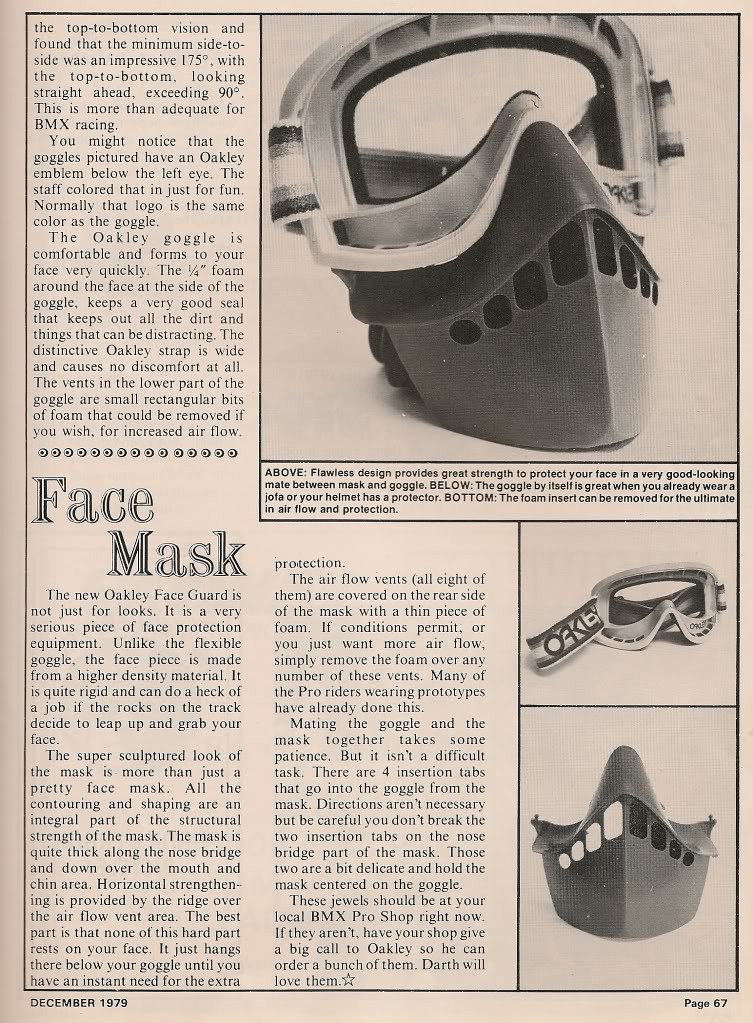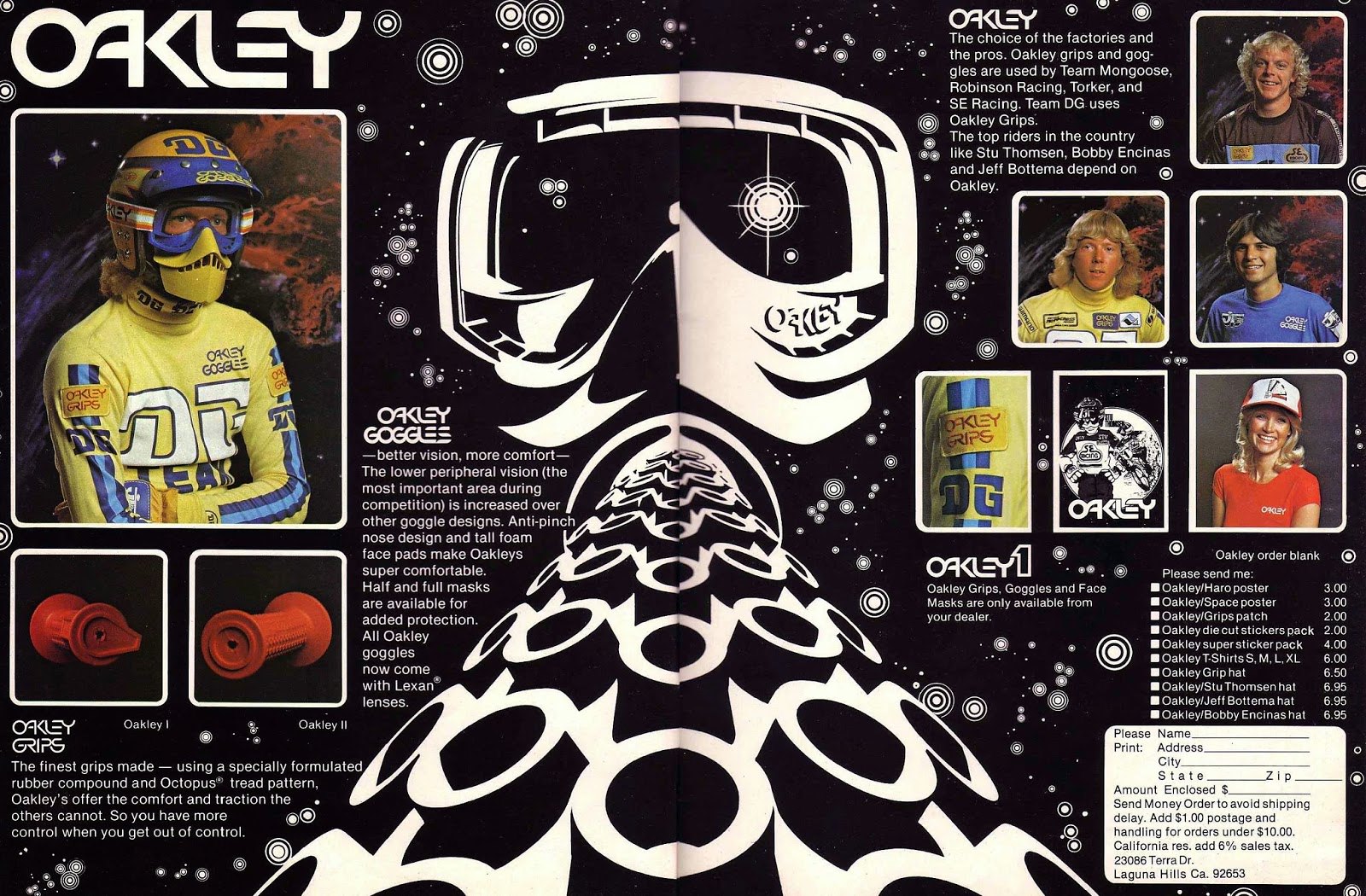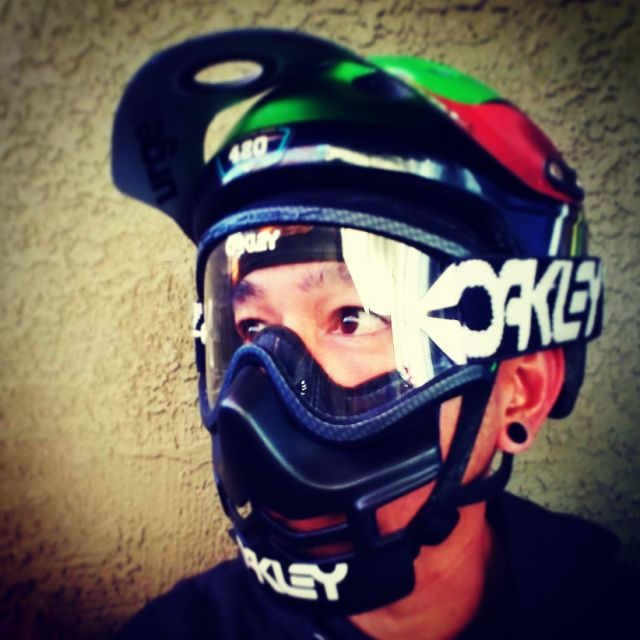Dann,
Glad to help and to reply to some of your questions and observations:
"O Frame with Iridium being listed in an early catalog."
I'm sure this was a case where the catalog was produced before we had naming architecture dialed in.
Same answer for the "P" Frame. I clearly remember that. It ended up being Pro Frame.
As for logos. When we decided that the classic logo felt heavy and slow it was time to update the brand mark. It was not easy and I recall it taking about 2 years to finally settle on the Ellipse Icon. For awhile it carried the this stretch underneath as a secondary, but after awhile it felt too "busy". The stretch logo, both thin and heavy, was just hard to work with and if not done perfectly it looked terrible. The Ellipse by itself became the primary brand mark and later on we also had a version with "Oakley" spelled out beneath in a stronger "Bark" font. This was mostly to appease certain markets where the "O" by itself was unknown.
"From the marketing material, it seems they are similar to the MX frame but with extra vents and hydrophobic coating. Sort of along the lines of the Water Jacket vs Racing Jacket."
We didn't really make any comparisons between the H20 goggle and the Water Jacket, but your analogy and product attributes line up.
The H20 Goggle came from the Jetski racing world where the racers wear helmets and were already using a standard MX goggle with some of their own modifications. The problem was that it fogged easy, the face foam held on to water, was uncomfortable to the face when wet and the vent foam acted like a rain cloud. We solve those issues by taking the O Frame, adding vent holes to the brow of the frame, added anti fog and changed the face foam to a closed-cell foam that didn't absorb water. I recall we even left out the vent foam so water could easily flow through the goggle. Simple fixes, but first of its kind.
The Water Jacket was born from a need of surfers who were spending countless hours in the water with their eyes unprotected. We liked the Racing Jacket for its hingeless and full orbital frame. To your observations we vented the lens so it wouldn't fog, added a head leash and provided a water repel liquid that could be reapplied as needed. Like the H20 goggle it was a niche market, but one we could bring an authentic solution to a problem. The Water Jacket ended up being popular in a variety of water sports. We also used it as a protective sports glass for sports like basketball and soccer. Same idea as the M Frame Slash.
Regarding the Stretchline, I have a few articles on the subject.
http://o-review.com/forum_detail.php?ID=10717
You seem to nail the Stretch strategy from afar. Now you know a little more of the background about Jamin driving it and it being an exclusive, including the Stretch display, to a core distribution network. It wasn't OPD as it had passed, but more directly focused on surf, skate and music.
But this Stretch is not to be confused with some early stretch logo usage. E Wires, Zeros, some M Frames. That stretch logo was simply during an era we thought the thin stretch logo was permanent. Instead we shortly changed everything to the Ellipse Icon.
"With the recent departure of the Square O, this sentiment was shared by a lot of people. The elliptical icon just looks funny on the lifestyle pieces. The reasoning was pretty much in line with how you mentioned the initial reaction was shock. They're backpedaling to reach that safe zone for brand identity."
I didn't know that only using the Ellipse was the new mandate. As much as separately marketing the Square O versus the Ellipse was a pain it worked well. It also opened up the design parameters, but Lux doesn't like complexity so I can see where this is coming from.
"1999/2000 saw a lot of updates. A few: the O Matter formula was improved so the frames weren't so brittle. The first wave of Jacket sunglasses stay safely on my shelf. I get nervous even touching them. True Metal icons appears to replace the molded icons. Most O Matter options were rebranded as 'New' models, while the Wires became 2.0 versions."
We were constantly evolving. I think the first big wave of improvement came in 1991-1993. Without a doubt we upped our game at this point. Somewhat because we could afford better materials and engineering, but also because we were getting killed on broken Blade and RZR arms. Later we also got killed on Eye Jacket arms breaking right at the front of the sock sleeve. Material was one thing, but we also improved the molding process to assure we didn't have "knit" or seam lines right in high stress areas.
Shortly after as we got ready to go public I'm also thinking this was about the same time the brand palette moved to black from berry, started to change the logo and we moved out of plastic boxes and into a more elegant packaging presentation. We launched E Wire, Eye Jacket and later, Trenchcoat. These styles were major turning points for Oakley as these styles clearly hit the mainstream. X Metal is launched shortly thereafter and was a major disruption to the sunglass industry. Totally new frame technology that no one could wrap their heads around. However, we struggled at first with Romeo (Romeo and Juliet were named after cigars). Not what people expected from Oakley, high priced and radical designs. We ended up added Iridium lens options to color them up, received huge exposure on Mission Impossible and all of a sudden X Metal exploded in popularity.
In the late 90's we began another refresh in our positioning to be one of premium, especially as we entered more of the lifestyle segments. Material quality always ebbed and flowed, but we were now on the cutting edge of everything we did. We were also beginning to feel another softening phase of sales and plateau that knew we needed to reinvent who we were and what we could stand for. Jim was amazing during times like this and recognized it was time for us to add more detail to what we were doing. Words like "luxury" and "fashion" were first spoken in our performance vocabulary. Heck we made women's high heels! Talk about a collectors item. Does anyone have the women's Hollow Point Heels?
It's this one. I picked it up due to the striking resemblance to the 1980 Oakley Goggle. The price point was $30, so cheaper then the 90's release, and not too much more than the 80's. I assume simple curved Lexan vs the optically corrected lenses of other modern releases. Only three colors appeared and soon disappeared. I don't doubt that sometimes naming schemes get confusing. Here we are in this thread, still trying to hash them out after all.
Not much that is exciting or proud about this release. Going backwards maybe looking for the low price point consumer. For lenses, most MX goggles use a simple, flat, die cut Lexan lens. To the best of my knowledge the only MX goggles with an optically correct and high impact lens material (Plutonite) are Airbrake and Mayhem MX.
Phew!
Scott







